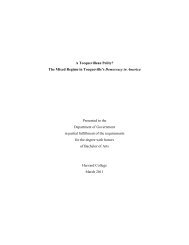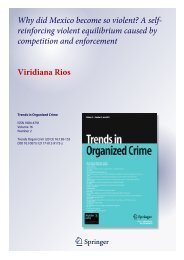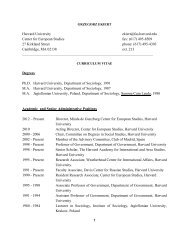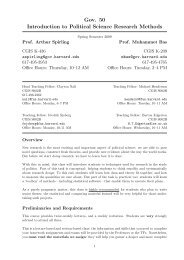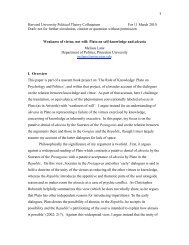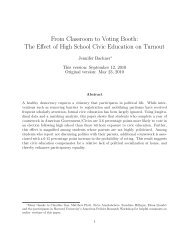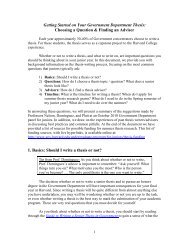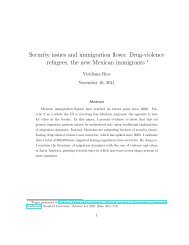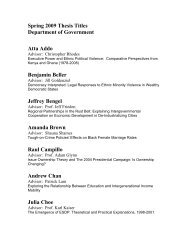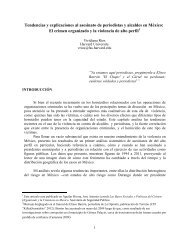Supreme Court Agenda Setting in a System of Shared Powers Ryan ...
Supreme Court Agenda Setting in a System of Shared Powers Ryan ...
Supreme Court Agenda Setting in a System of Shared Powers Ryan ...
You also want an ePaper? Increase the reach of your titles
YUMPU automatically turns print PDFs into web optimized ePapers that Google loves.
18 The Journal <strong>of</strong> Law, Economics, & Organization. V0 N0<br />
reversed the tribunal below it, and when the lower court struck down a federal<br />
law. Most <strong>of</strong> the other coefficients behaved as expected.<br />
To check the robustness <strong>of</strong> these f<strong>in</strong>d<strong>in</strong>gs, I engaged <strong>in</strong> a number <strong>of</strong> analyses.<br />
First, I refit all <strong>of</strong> my models us<strong>in</strong>g alternative specifications <strong>of</strong> the standard<br />
errors. That is, I re-estimated every model us<strong>in</strong>g asymptotic standard errors<br />
<strong>in</strong>stead <strong>of</strong> robust standard errors. None produced results supportive <strong>of</strong> the SOP<br />
model. Second, I refit all the models compar<strong>in</strong>g only the constra<strong>in</strong>ed <strong>Court</strong><br />
with the unconstra<strong>in</strong>ed <strong>Court</strong> (i.e. omitt<strong>in</strong>g observations where the <strong>Court</strong> was<br />
semi-constra<strong>in</strong>ed). The results still did not support the SOP prediction. 27 Third,<br />
I estimated the Bayesian Information Criterion (BIC) for every model, compar<strong>in</strong>g<br />
the BIC <strong>in</strong> the SOP model to the BIC <strong>in</strong> a controls-only model. As<br />
Bonneau et al. (2007, 901) expla<strong>in</strong>, the BIC “compares two nonnested models<br />
by look<strong>in</strong>g at the Bayes Factor, which reduces to the ratio <strong>of</strong> posterior<br />
odds.” The BIC, <strong>in</strong> essence, compares non-nested by “compar<strong>in</strong>g the probability<br />
that each model is the true model given the observed data” (Bonneau et al.,<br />
2007, 901). The model with the smallest BIC is the best model given the data<br />
(Primo, B<strong>in</strong>der and Maltzman, 2008). In every comparison <strong>of</strong> SOP models to<br />
controls-only models, the controls-only BIC was at least 4.352 smaller than the<br />
SOP model, provid<strong>in</strong>g positive support for a non-SOP model <strong>of</strong> agenda-sett<strong>in</strong>g<br />
(Long and Freese, 2006, 113).<br />
As yet a further robustness check, I recoded the SQ as the policy <strong>of</strong> the<br />
lower court’s decision rather than the statute <strong>in</strong> the case. To do so, I analyzed<br />
the Judicial Common Space scores <strong>of</strong> the federal judges presid<strong>in</strong>g over the dispute<br />
<strong>in</strong> the court below (Epste<strong>in</strong> et al., 2007). When the petition arose from a<br />
federal circuit court or a three-judge district court panel, I coded the ideology<br />
<strong>of</strong> the median judge on the panel. 28 When the case was appealed from a onejudge<br />
district court, I followed the cod<strong>in</strong>g methodology <strong>of</strong> Giles, Hett<strong>in</strong>ger and<br />
Peppers (2001) and Epste<strong>in</strong> et al. (2007) and coded the status quo as the JCS<br />
score <strong>of</strong> the district judge who presided over the case. Figure 5 presents the<br />
difference <strong>in</strong> predicted probabilities <strong>of</strong> a constra<strong>in</strong>ed <strong>Court</strong> vot<strong>in</strong>g to review a<br />
case versus an unconstra<strong>in</strong>ed or semi-constra<strong>in</strong>ed <strong>Court</strong> elect<strong>in</strong>g to review that<br />
case. As Figure 5 shows, the difference between the predicted probability <strong>of</strong><br />
a constra<strong>in</strong>ed <strong>Court</strong> and unconstra<strong>in</strong>ed or semi-constra<strong>in</strong>ed <strong>Court</strong> vot<strong>in</strong>g to review<br />
is never statistically significant <strong>in</strong> any <strong>of</strong> the legislative models. 29 That is,<br />
the <strong>in</strong>terval around the average difference between the predicted probabilities<br />
conta<strong>in</strong>s 0, which means that I cannot reject the null hypothesis that there is no<br />
separation <strong>of</strong> powers <strong>in</strong>fluence. Simply put, there are no systematic differences<br />
between the probability that a constra<strong>in</strong>ed or non-constra<strong>in</strong>ed <strong>Court</strong> will grant<br />
review to cases.<br />
27. I refit these models as well us<strong>in</strong>g asymptotic standard errors. The results were equally<br />
unsupportive.<br />
28. In cases where a lower court judge filed a dissent or special concurrence I coded the status<br />
quo as the midpo<strong>in</strong>t between the two judges <strong>in</strong> the majority. If the lower court reviewed the case<br />
en banc, I coded the status quo as the median judge <strong>in</strong> the en banc majority.<br />
29. These results also hold up under alternative specifications <strong>of</strong> the standard errors.



